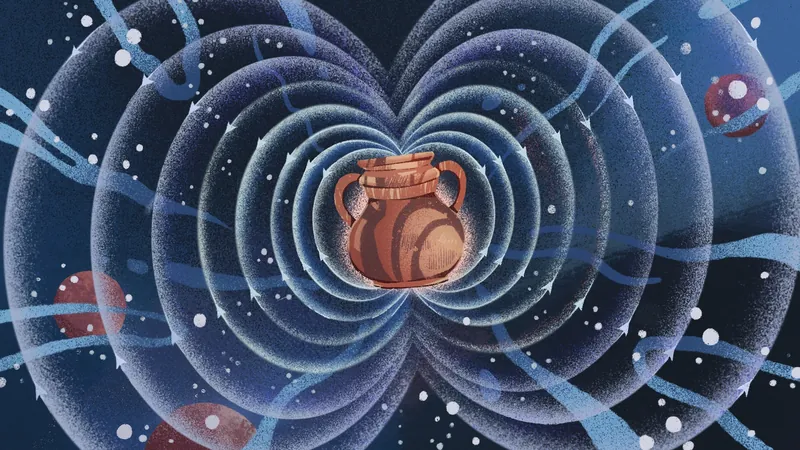
Unlocking Earth’s Magnetic Mysteries: How Ancient Crystals Could Explain Our Weakening Shield
2025-07-18
Author: Jia
A Bizarre Discovery from the Past
In a remarkable twist of fate, archaeologist Erez Ben-Yosef stumbled upon a piece of Iron Age "trash" in 2008 that unveiled the most significant magnetic-field anomaly ever recorded — an event that took place around 3,000 years ago. Working in southern Jordan with geologist Ron Shaar, Ben-Yosef's discovery led to the identification of intense fluctuations in Earth's magnetic field during the Iron Age.
Introducing the Levantine Iron Age Anomaly (LIAA)
Initially met with skepticism, the Levantine Iron Age Anomaly (LIAA) has since garnered acceptance within the scientific community after over a decade of detailed analysis. This anomaly unveiled a tumultuous magnetic landscape in the Middle East between 1100 and 550 B.C. using a cutting-edge method called archaeomagnetism. This technique allows researchers to delve deep into the magnetic properties of ancient materials, offering insights into the Earth’s magnetic history.
Why Should We Care About Earth's Magnetic Field?
Earth's magnetic field serves as a protective barrier against harmful cosmic radiation. Recent findings indicate that this magnetic shield is weakening, which could jeopardize satellite communications and heighten cancer risks. Understanding past magnetic behaviors becomes crucial for predicting future changes. However, the limited historical data, which only dates back to 1832, complicates these predictions.
The Fascinating Science Behind Archaeomagnetism
Archaeomagnetism exploits the heating processes used by our ancestors. When materials are heated, their internal particles become magnetically aligned with Earth's magnetic field. As these materials cool and solidify, they preserve a snapshot of the magnetic field, providing clues about its past behavior.
Challenges in Gathering Global Magnetic Data
Despite advancements in magnetic measuring technologies, such as powerful magnetometers, data collection remains uneven across the globe. A staggering 90% of the data gathered in the Geomagia50 database originates from Europe, leaving significant gaps in regions like Africa, which lacks adequate equipment for sampling.
What Lies Ahead? The Search for More Anomalies
The quest for a comprehensive understanding of Earth's magnetic history is at a critical juncture. The Levantine Iron Age Anomaly has reshaped previous assumptions about magnetic field strength, hinting at potentially significant repercussions for our modern world. Researchers are particularly keen to investigate the enigmatic South Atlantic Anomaly (SAA), which has already disrupted satellite communications due to its weakened magnetic field.
The Broader Implications of Magnetic Research
As the number of satellites orbiting Earth soars — projected to jump from 13,500 to 54,000 by 2030 — understanding the intricacies of our magnetic field is paramount. The consequences of anomalies like the SAA could lead to increased data corruption in satellite systems, stressing the need for continued research.
The Future of Archaeomagnetism: Expanding Global Insights
Exciting developments in archaeomagnetism are underway across the globe, with new projects emerging in the U.S. and preliminary studies in regions previously unexplored. The aim is to contribute to a more thorough understanding of historical magnetic changes and their implications for the future, uncovering more anomalies that might hold the keys to our planet’s magnetic mysteries.




 Brasil (PT)
Brasil (PT)
 Canada (EN)
Canada (EN)
 Chile (ES)
Chile (ES)
 Česko (CS)
Česko (CS)
 대한민국 (KO)
대한민국 (KO)
 España (ES)
España (ES)
 France (FR)
France (FR)
 Hong Kong (EN)
Hong Kong (EN)
 Italia (IT)
Italia (IT)
 日本 (JA)
日本 (JA)
 Magyarország (HU)
Magyarország (HU)
 Norge (NO)
Norge (NO)
 Polska (PL)
Polska (PL)
 Schweiz (DE)
Schweiz (DE)
 Singapore (EN)
Singapore (EN)
 Sverige (SV)
Sverige (SV)
 Suomi (FI)
Suomi (FI)
 Türkiye (TR)
Türkiye (TR)
 الإمارات العربية المتحدة (AR)
الإمارات العربية المتحدة (AR)